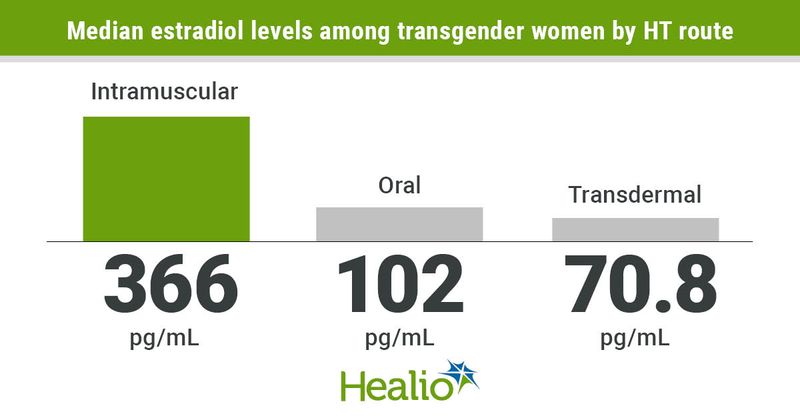Estradiol levels higher with injection vs oral, transdermal HT for transgender women
Intramuscular injections resulted in higher levels of estradiol than oral and transdermal routes for transgender women, whereas all hormone therapy routes result in similar testosterone levels in transgender men, according to study data.

“We show the hormone levels for transgender men and women, after a variety of different gender-affirming hormone regimens, that these regimens are effective in raising sex hormone concentrations into the affirmed range of the affirmed gender,” Vin Tangpricha, MD, PhD, professor of medicine in the division of endocrinology, metabolism and lipids at Emory University School of Medicine, told Healio. “Transmasculine regimens show that patches/gels and shots are equally as effective in achieving good male ranges of testosterone. Transfeminine regimens show that shots result in higher levels of estradiol, which should be taken into account when deciding between shots, pills or patches.”

Tangpricha and colleagues conducted a retrospective study of 196 people who underwent gender-affirming HT at the Emory Clinic and Emory University Hospital from 2000 to September 2018. Transgender women (n = 134) received estrogen of various types, with administration via oral, intramuscular and transdermal routes. Transgender men (n = 62) were prescribed testosterone, which was administered in nearly all patients through intramuscular injection. Regular hormone testing was conducted during outpatient visits. Blood tests were performed every 3 to 6 months for those initiating HT, and 6 to 12 months for people who had been on a stable regimen 2 years after HT began. Study findings were published in Endocrine Practice.
Transgender women had 647 treatment visits during the study period, whereas transgender men had 294 visits. In both cohorts, older age and a history of gonadectomy were associated with higher sex hormone levels.
Among transgender men, those receiving transdermal HT had a lower median total serum testosterone level compared with those receiving injections (326 ng/dL vs. 524.5 ng/dL). Higher testosterone doses were associated with higher hormone concentrations. Those receiving less than 50 mg per week had a median testosterone level of 442.5 ng/dL, people receiving 50 mg to 75 mg per week had a median level of 483 ng/dL, and those receiving more than 75 mg per week had a median testosterone level of 588 ng/dL.
Oral (n = 366) and intramuscular (n = 242) HT were more common among transgender women than transdermal HT (n = 39). Of those taking oral estradiol, 45.6% received 15 mg to 30 mg per week, and 36.3% received more than 30 mg per week. Most participants taking intramuscular estradiol received more than 10 mg per week. Among transgender women, those receiving intramuscular injections had higher total serum estradiol concentrations (366 pg/mL) compared with oral (102 pg/mL) and transdermal estradiol (70.8 pg/mL; P < .001).
Transgender women receiving an oral dose had higher estradiol concentrations as the dose increased. Those receiving less than 14 mg per week had a median level of 58 pg/mL, participants receiving 15 mg to 30 mg per week had a median estradiol level of 90.7 pg/mL, and those receiving a weekly dose of more than 30 mg had a median level of 140 pg/mL. A daily dose of 4 mg to 5 mg of estradiol was associated with an estradiol concentration of 93.5 pg/mL, close to minimum suggested levels for transgender women.
“The starting oral dose of estradiol in transgender females may not result in adequate estradiol concentrations,” Tangpricha said.
The researchers also observed a large variation in estradiol concentrations for transgender women taking estradiol pills, according to Tangpricha. He said more research is needed to assess the best time to conduct an accurate blood test after oral estradiol is administered.
“Also, we need more studies to understand what is the best dose that results in the least number of side effects,” Tangpricha said.
For more information:
Vin Tangpricha, MD, PhD, can be reached at vin.tangpricha@emory.edu.

